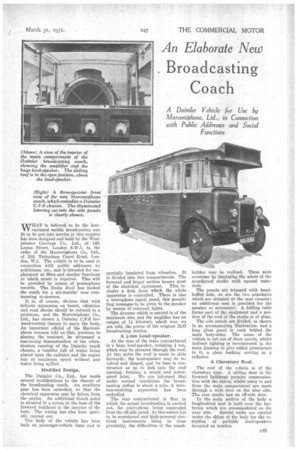An Elaborate New
Page 67

If you've noticed an error in this article please click here to report it so we can fix it.
Broadcasting Coach
A Daimler Vehicle for Use by Marconiphone, Ltd., in Connection with Public Addresses and Social Functions
WHAT is believed to be the bestequipped mobile broadcasting outfit to be put into service in this country has been designed and built by the Westminster Carriage Co., Ltd., of 149, Lupus Street, London S.W.1, to the order of the Marconiphone Co., Ltd., of 210, Tottenham Court Road, London, W.1. The vehicle is to be used in connection with public addresses by politicians, etc., and is intended for employment at fetes and similar functions at which music is required. This will be provided by means of gramophone records. The Daily Mai/ has booked the coach for a six-months' tour commencing to-morrow.
It is, of course, obvious that with delicate apparatus on board, vibration and road shocks should be reduced to a minimum, and the Marconiphone Co., Ltd., has chosen a Daimler 0.10.6 forward-control chassis to carry the body. An important official of the Marconiphone concern told us that, previous to placing the contract, he witnessed a convincing demonstration of the vibrationless running of the Daimler coach chassis, a tumbler full of water being placed upon the radiator and the engine run at maximum speed without any water being spilled.
Modified Design.
The Daimler Co., Ltd., has made several modifications to the chassis of the broadcasting coach. An auxiliary gear has been embodied, so that the electrical apparatus may be driven from. the engine. An additional clutch pedal is situated in a recess at the base of the forward bulkhead in the interior of the body. The wiring has also been specially carried out.
The body of the vehicle has been built on passenger-vehicle lines and is specially insulated from vibration. It is divided into two compartments. The forward and larger section houses most of the electrical equipment. This includes a desk from which the whole apparatus is controlled. There is also a microphone signal panel, this permit. ring messages to be given to the speaker by means of coloured lights. The dynamo which is carried is of the maximum size, and the amplifier has an output of 1 kilowatt, which was, we are told, the power of the original 2L0 broadcasting station.
A i-ton Loud-speaker.
At the rear of the main compartment is -a huge loud-speaker, weighing ton, which may be elevated through the roof. At this point the roof is made to slide forwards ; the loud-speaker may be revolved and dipped, and its base is constructed so as to lock into the roof opening, forming a sound and water proof joint. We are informed that under normal conditions the broadcasting radius is about a mile. A wireless-receiving apparatus has been embodied.
The rear compartment is that in which the actual broadcasting is carried out, the microphone being suspended from the oil-side panel. As this saloon has to be soundproof and high-powered electrical instruments being in close proximity, the difficulties of the coaoh
builder may be realized. These were overcome by insulating the whole of the soundproof studio with -special materials.
The panels are trimmed with handbuffed hide, as are the two armchairs which are situated at the rear corners; an additional seat is provided for the speaker or announcer. A folding table forms part of the equipment and a portion of the roof of the studio is of glass.
The side panels are divided, as shown in an accompanying illustration, and a long glass panel is sunk behind the main body-sides. The name of the vehicle is cut out of these panels, whilst indirect lighting is incorporated in the main framing to give added prominence to it, a glass backing serving 118 a reflector.
A ClereStory Roof.
The roof of the vehicle is of the clerestory type. A sliding door in the forward bulkhead permits communication with the driver, whilst entry to and from the main compartment are made through a wide door on the near side. The rear studio has an off-side door.
In the main section of the body a longitudinal seat is built over the batteries, which are accommodated On the near side. Special racks are carried under the skirts of the body for the reception of portable loud-speakers mounted on trestles.












































































































